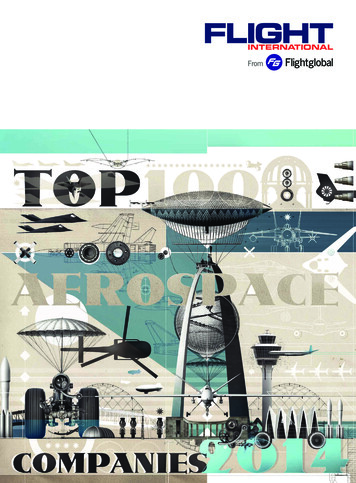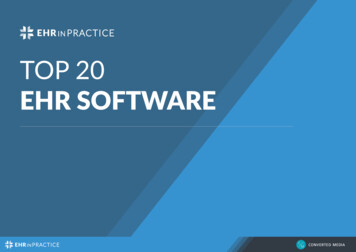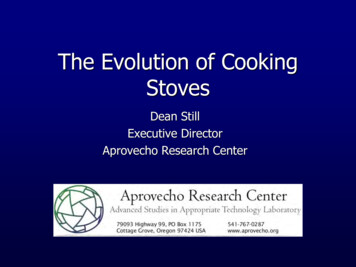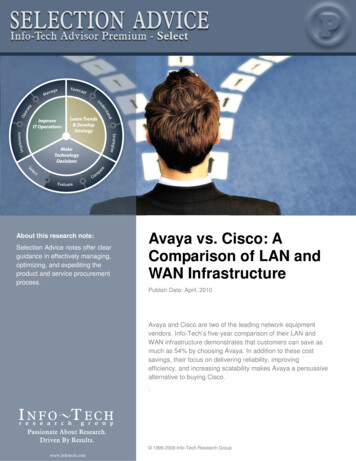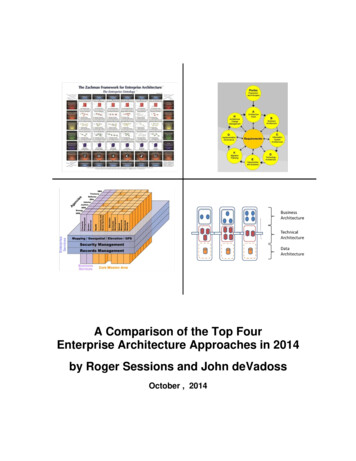
Transcription
A Comparison of the Top FourEnterprise Architecture Approaches in 2014by Roger Sessions and John deVadossOctober , 2014
Table of ContentsAbout the Authors . 1Introduction . 2Three Fundamental Questions . 4A Closer Look at the Four Approaches . 4Definition of Terminology . 7A Brief History of Enterprise Architecture . 8Case Study . 12The Perspective Centric Approach (Zachman) . 15The Process Centric Approach (TOGAF). 19The Standardization Centric Approach (FEA) . 26The Capability Centric Approach (VRF/SIP) . 33Comparison . 43Conclusion . 47Glossary . 49References . 522014 Microsoft Corporation. All rights reserved. This document is provided "as-is."Information and views expressed in this document, including URL and other InternetWeb site references, may change without notice. You bear the risk of using it. Someexamples are for illustration only and are fictitious. No real association is intended orinferred. This document does not provide you with any legal rights to any intellectualproperty in any Microsoft product. You may copy and use this document for yourinternal, reference purposes.
About the AuthorsRoger Sessions (roger@objectwatch.com) is the world’sleading expert in IT Complexity Analytics and the developerof The Snowman Architecture, a capability focused approachto enterprise architecture. He has written seven books, dozensof influential articles, and given lectures at conferencesthroughout the world. He has been a guest professor of ITComplexity Analytics at the University of the Andes and atwo time keynote speaker at the highly prestigious GartnerResearch Board on the topic of IT Complexity Management.His ground breaking work in Enterprise Architecture and IThas earned him recognition as a Fellow of the InternationalAssociation of Software Architects.Roger Sessions offers workshops and mentoring in Enterprise Architecture and the SnowmanPractice. His website is www.objectwatch.com, and his blog issimplearchitectures.blogspot.com.John deVadoss has over 17 years of experience in thesoftware industry; he has been at Microsoft for over 13 years,all of it in the enterprise space – as a consultant, as a programmanager in the distributed applications platform division, asan architect working with some of Microsoft’s key partners,director of architecture strategy, leading technical strategy forthe application platform, and most recently as product unitmanager of patterns & practices. He is currently GeneralManager for the Enterprise Services Strategy program.His areas of interest are broadly in distributed applicationarchitectures, data and metadata, systems management and currently on edge architectures(both services and access) aka cloud computing, but most of all in creating business valuefrom technology investments. He has published books on topics such as Service-OrientedArchitecture, Collaboration, and Cloud Computing among others. John has a MS in ComputerScience from the University of Massachusetts at Amherst where he dabbled in AI, getting hisdegree in Machine Learning. He spent a year in the PhD program in Computer Science – andhe still harbors visions of going back to complete the program at some point in his career.4 EA ComparisonsRoger Sessions and John deVadossPage 1
IntroductionThe year 2014 marks a full quarter century of enterprise architecture. In that time a number ofenterprise architectural approaches have come and gone.Should you care about a field that is twenty-five years old? It depends. This field wasinaugurated to address two major problems in information technology that were twenty-fiveyears ago already becoming apparent. The first problem was managing the increasingcomplexity of information technology systems. The second problem was the increasingdifficulty in delivering real business value with those systems.As you can imagine, these problems are related. The more complex a system, the less likely itis that it will deliver its promised business value. As you better manage complexity, youimprove your chances of delivering real business value.Today, four general approaches or understandings of enterprise architecture dominate thefield. The perspective centric approach focuses on understanding different perspectiveswithin the enterprise. The process centric approach focuses on the process that is used todefine the deliverables. The standardization centric approach focuses on defining andenforcing the use of standard approaches throughout the enterprise. The capability centricapproach focuses on understanding the capabilities of the organization (what it does) andwhich of those capabilities can be made more efficient through better use of technology or byoutsourcing.These four approaches share little except the name enterprise architecture. The goal of thiswhite paper is to help you understand the differences between these four approaches so thatyou can make the best possible choice as to which will work best in your enterprise solvingthe problems that you need solved.So should you care about this field? It depends on how you feel about positively impactingyour organization’s bottom line. If managing system complexity and delivering businessvalue are key priorities for you, then you should care about enterprise architecture. If you arefocused on maintaining or rebuilding IT’s credibility in your organization or if you strive topromote the use of IT to maintain a competitive position in your industry, then you shouldcontinue reading this white paper. If these issues don’t concern you, then these methodologieshave little to offer.As systems become more complex they generally require more planning. It is easy to see thisin buildings. When Henry David Thoreau built his little cabin on Walden’s Pond (shown inFigure 1) he embraced simplicity and needed no architect. If you are building New York City(shown in Figure 2) simplicity is out of the question and you will need architects.4 EA ComparisonsRoger Sessions and John deVadossPage 2
Figure 1. Thoreau’s cabin at Walden Pond, as drawn by Thoreau’s sister, Sophia ThoreauFigure 2. New York CityThe relationship between complexity and planning for buildings and cities is similar forinformation systems. If you are building a simple, single-user, non-distributed system, youmight not need any architects at all. If you are building an enterprise-wide, mission critical,highly distributed system, you might need a database architect, a solutions architect, aninfrastructure architect, a business architect and an enterprise architect.This paper is about the methodologies needed to develop the overall architectural vision foran organization. This is the responsibility of the enterprise architect. This is the architect whospecializes in the broadest possible view of architecture within the enterprise. This is the4 EA ComparisonsRoger Sessions and John deVadossPage 3
architect’s architect, the architect who is responsible for coordinating the work of all of theother architects. Do you need such an architect? It all depends on what you are building:Thoreau’s cabin or New York City.Building a large, complex, enterprise-wide information system without an enterprise architectis like trying to build a city without a city planner. Can you build a city without a cityplanner? Probably. Would you want to live in such a city? Probably not.Of course, hiring a city planner does not guarantee you will build a livable city, it merelyimproves your chances. Similarly, having an enterprise architect does not guarantee you willrealize the business benefits from enterprise architecture. There are many examples of failedenterprise architectures in the world today and most of them had enterprise architects(probably dozens!) Architectural methodologies can help, but they only go so far. We willalso discuss some of the reasons for these failures, and how to avoid them.Three Fundamental QuestionsBefore any enterprise embarks on a program of enterprise architecture, there are threefundamental questions the enterprise must be able to answer. The questions are these: How do we define enterprise architecture?What will be the business benefit of doing enterprise architecture?How we will measure the business benefit of having done enterprise architecture?If an enterprise cannot answer these three questions, then it has no justification for starting (orcontinuing) an enterprise architecture program. Unfortunately, as we will soon see, it is easierto ask these questions that it is to answer them.A Closer Look at the Four ApproachesBefore we explore the dominant approaches to Enterprise Architecture we need to start bydefining what we mean by Enterprise Architecture. It turns out that this term is not welldefined.In September 2012, I (Roger) started a thread on the Linked-In group The EnterpriseArchitecture Network asking practicing Enterprise Architects to define EnterpriseArchitecture. Over the next six months more than 150 replies were posted. While the range ofthe definitions made it clear that there is no common agreement, four approaches to enterprisearchitecture seem to emerge1.1Each of these authors has kindly given us permission to include their quotes. However this does not imply thatthey would agree with this four-way classification of enterprise architecture or that they would agree with ourcharacterization of their quotation.4 EA ComparisonsRoger Sessions and John deVadossPage 4
The first approach is illustrated by this comment:EA, as the name states, is the architecture that is the integrated blueprint of theenterprise. EA, simply put, describes the enterprise from many angles that serve itsvarious stakeholders.- Adrian GrigoriuWe call this approach perspective centric, because it is focusing on the need to ensure that allof the different perspectives within the organization have been adequately considered. Themethodology that best represents this approach is The Zachman Framework for EnterpriseArchitectures usually just called Zachman.The second approach is illustrated by this comment:EA is a rigorous model of the motivations, structures, information, processes, and systems ofan enterprise created for the purpose of decision support.- Nick Malik2We call this approach process centric because it implies the need to focus on the process usedto model the enterprise. The methodology that best represents this approach today is TheOpen Group Architecture Framework (TOGAF ).The third approach is illustrated by this comment:Enterprise Architecture isa) a plan for the fundamental structure of systems which comprise and support theenterprise together with the context of those systems and the principles governing thedevelopment and evolution of those systemsb) the activity of creating the architecture described above through a process ofanalyzing, assessing and documenting the context & environment of the systems,researching options and making decisions for the systems components, structures &principles; together with the communication of that architecture to interested partiesand governance activities to ensure the architecture decisions are adhered to across theorganization.- Richard Hillier2This is expanded upon in his blog at architecture.aspx4 EA ComparisonsRoger Sessions and John deVadossPage 5
We call this approach standardization centric, because it is focusing on the need to definestandard practices, reference models, and common services that are understood through theenterprise. The methodology that best represents this perspective is Federal EnterpriseArchitecture (FEA).The fourth approach is illustrated by this comment:EA is about optimizing technology investment to best deliver desired businesscapabilities.- Ed KleinWe call this approach capability centric, because it focuses on the capabilities within theenterprise and how best to improve them with technology. The methodology that bestrepresents this perspective is the Value Realization Framework (VRF) coupled with SimpleIterative Partitions (SIP).As you can see, these four approaches are quite different. Which should your organizationfollow? It depends on what you are trying to accomplish. A good starting point to making thechoice is to look at how each of these four perspectives might answer the three fundamentalquestions and see which most closely resonates with your enterprise. Figure 3 summarizes theanswers.Figure 3. Four Approaches on the Three Fundamental Questions4 EA ComparisonsRoger Sessions and John deVadossPage 6
Definition of TerminologyBefore we get too far into comparing the approaches that make up the enterprise architect’stoolkit, we need to define some terms. This is especially important in an article that iscomparing Enterprise Architectural approaches since the different approaches sometimes usesimilar terms to mean different things.For example, we have two approaches that describe themselves as enterprise architecturalframeworks: the Zachman Framework for Enterprise Architectures and The Open GroupArchitectural Framework (TOGAF). Yet these two methodologies share little in commonother than the words enterprise, architecture, and framework.So we will start by defining the terms as used in this white paper. Those definitions markedwith asterisk are taken mostly from IEEE-1471-2000 [01], whose definitions are used wherethey exist and make sense.architect – One whose responsibility is the design of an architecture and the creation of anarchitectural description.architectural artifact – A specific document, report, analysis, model, or other tangible thatcontributes to an architectural description.architectural description* – A collection of products (artifacts) that taken together documentan architecture.architectural framework – A skeletal structure that defines suggested architectural artifacts,describes how those artifacts are related to each other, and provides generic definitions forwhat those artifacts might look like.architectural methodology – A generic term that can describe any structured approach tosolving some or all of the problems related to architecture.architectural process – A defined series of actions directed to the goal of producing either anarchitecture or an architectural description.architectural taxonomy – A methodology for organizing and categorizing architecturalartifacts.architecture* – The fundamental organization of a system embodied in its components, theirrelationships to each other, and to the environment, and the principles guiding its design andevolution.4 EA ComparisonsRoger Sessions and John deVadossPage 7
enterprise architecture – An architecture in which the system in question is the wholeenterprise, especially the business processes, technologies, and information systems of theenterprise.Now that we have a common understanding of these key terms, we can take you through thehistory of enterprise architecture methodologies, discuss the problems these methodologiesare trying to solve, and compare the top four methodologies in terms of their approach andtheir relationship to each other.A Brief History of Enterprise ArchitectureThe field of enterprise architecture started in 1987 with the publication in the IBM SystemsJournal of an article titled, “A framework for information systems architecture,” by J.A.Zachman. In that paper, Zachman laid out both the challenge and the vision of enterprisearchitectures that would guide the field for the next 25 years. The challenge was to managethe complexity of increasingly distributed systems. As Zachman said:The cost involved and the success of the business depending increasingly on itsinformation systems require a disciplined approach to the management of thosesystems. [02]Zachman’s vision was that business value and agility could best be realized by a holisticapproach to systems architecture that explicitly looked at every important issue from everyimportant perspective. His multi-perspective approach to architecting systems is whatZachman originally described as an information systems architectural framework and soonrenamed to be an enterprise architecture framework.Zachman was a major influence on one of the earliest attempts by a branch of the U.S.Government, the Department of Defense, to create an enterprise architecture. This attemptwas known as the Technical Architecture Framework for Information Management (TAFIM)[03]. TAFIM was introduced it in 1994.The promise of enterprise architectures, such as TAFIM, to better align technical projects withbusiness need was noticed by no less a body than the U.S. Congress. Most likely influencedby the promised benefits of TAFIM, Congress in 1996 passed a bill known as the ClingerCohen Act [04], also known as the Information Technology Management Reform Act, whichmandated that all federal agencies take steps to improve the effectiveness of their ITinvestments. A CIO Council, consisting of CIOs from all major governmental bodies, wascreated to oversee this effort.In April 1998, the CIO Council began work on its first major project, the Federal EnterpriseArchitecture Framework (FEAF). Version 1.1 [05] of this framework was released inSeptember, 1999. This document contained some innovative ideas such as “segmentedarchitectures”, that is, architectural focus on segmented subsets of the larger enterprise.4 EA ComparisonsRoger Sessions and John deVadossPage 8
Over time responsibility for federal enterprise architecture moved from the CIO Council tothe Office of Management and Budget (OMB). In 2002 the OMB evolved and renamed theFEAF methodology as the Federal Enterprise Architecture (FEA). We will describe FEA ingreater detail in the section on standardization focused approaches.Two documents that have come out in the last few years that are relevant to the future of FEA.The first document is the 25 Point Implementation Plan to Reform Federal InformationTechnology Management by then United States Chief Information Officer, Vivek Kundra[06]. This document was released in December 2010. Although Kundra is no longer in thisposition, this document still wields considerable influence. The 25 Point Plan (as it is oftencalled) is Kundra’s vision for how IT can be revamped in the Federal government. It is worthnoting that enterprise architecture in general and FEA specifically is never mentioned. Thismakes it seem that at least at the CIO level of the government, EA is not consideredstrategically important.Another issue that will likely surface in the next few years is the 25 Point Plan’s emphasis oncloud architecture. Kundra saw the cloud as a strategically critical move for the FederalGovernment. The current version of FEA appears to be pretty poorly aligned with the cloudplatform [07].The second relevant document is the Common Approach to Federal Enterprise Architecturereleased in May 2012 [08]. Given that this is one of the few documents issued by theexecutive branch on the topic of FEA in recent years, one would expect a robust update of amajor framework. Instead, the Common Approach is an anemic document (barely 40 pageswithout appendices) that spends more time justifying FEA than showing how it is used.Reading between the lines of these two documents, it seems that the energy behind FEA isdissipating. We expect that over the next few years we will see a major shift in the attitudetoward FEA within the Federal Government.Despite the very significant enterprise architectural activity in the Federal Government (onecould argue that no organization has spent more money attempting to develop an enterprisearchitecture than the U.S. Government), progress has been slow and success stories areovershadowed by higher profile failures. In 2004, a full eight years after the Clinger-Cohenact mandated the use of effective IT planning processes, the General Accounting Office(GAO) reported the following:Only 20 of 96 agencies examined had established at least the foundation for effectivearchitecture management. Further, while 22 agencies increased in maturity since2001, 24 agencies decreased in maturity and 47 agencies remained the same. [09]4 EA ComparisonsRoger Sessions and John deVadossPage 9
Since January, 2005, the GAO has severely chastised a number of U.S. Agencies for failuresin their adoption or use of enterprise architecture. A few examples include the FBI [10], theDepartment of Defense [11], the Department of Homeland Security [12], and NASA [13].In 1998, four years after TAFIM (remember TAFIM?) was introduced and two years after itbecame codified as Clinger-Cohen, TAFIM was officially retired by the Department ofDefense.The work done on TAFIM was turned over to The Open Group. They morphed it into a newstandard that is today known as The Open Group Architectural Framework, better known byits acronym, TOGAF. TOGAF has gone through a number of iterations. The current versionof TOGAF and the one we will be discussing is 9.1. We will discuss TOGAF in the section onthe process centric approach.About the time that Zachman was developing his original ideas on Enterprise Frameworks,another thread was starting up that eventually would be highly influential in enterprisearchitecture. This thread was known as object-oriented programming.Object-oriented (OO) programming is a particular style of writing computer programs suchthat packages of code appear analogous to business objects; you ask an object to perform anaction, pass the object the information it needs to do so, and then get information back that isthe result of the action having been performed. For example, if one is implementing apurchase requisition system, one might have a Purchase Requisition object that you can askto Process Requisition, passing information in the form of parameters about the requisition,and receiving information back indicating the success or failure of the requisition.The reason object-oriented programming is interesting in the context of enterprise architectureis that this style introduced the concept that software systems could be analogous to businessprocesses. You could, for example, have a software object, Process Requisition, that mirroredthe business process. There was the hint of a correspondence between the business capabilityand the supporting technology.In theory, OO systems offered a separation between what an object did (its behavior) and howit did it (its implementation.) The separation was adjudicated by the object’s interface. Inpractice, this separation was poorly understood and rarely respected.OO systems became even more interesting in the mid-1990s when objects became distributed.With distribution, they took on a new name, components. It now became possible to ask acomponent to do something for you even if that component lived in a different address space,a different machine, or even in a different enterprise. This required that the idea of theinterface, the definition of what the component does, be taken much more seriously.Components were more and more described as black boxes. You put well defined things inand got well defined things out. What happened inside was opaque.4 EA ComparisonsRoger Sessions and John deVadossPage 10
By 1996 there were two major competing component (distributed object) systems. On theMicrosoft side, there was DCOM. On the other side, there was CORBA (Common ObjectRequest Broker Architecture.) CORBA was owned by a consortium known as the ObjectManagement Group (OMG). OMG was largely spearheaded by IBM, Sun, and Oracle withMicrosoft conspicuously absent. In 1996, DCOM (Microsoft) and CORBA (OMG) were twodistinct component worlds that could not communicate with each other.By 2002 the component world was starting to adopt a vendor-independent format for sendingmessages between components. This format was known as Simple Object Access Protocol(SOAP.) Now for the first time it was possible for both CORBA and DCOM components towork together. A new term was coined to describe this approach: Service-OrientedArchitectures (SOA.) What had originally been distributed objects and then components werenow services.Over the next five years there was increasing interest in merging the business processes withthe technology supporting them. Business processes became more and more described inservice-like language and services became more and more described in business process-likelanguage. A new term was born: capabilities. A capability was something the business didthat provided value and included the underlying supporting technology.In 2003, for example, when my (Roger’s) book Software Fortresses [14] came out, Idescribed a software fortress as consisting of strong boundaries which included the businessprocesses, technical support systems, and underlying data. The idea of a software fortress wasan early definition of what today we know as a capability.Microsoft was also very interested in the evolution of components into capabilities. They ofcourse were early pioneers in components through their DCOM technology. They werefurther influenced by a 2008 paper co-authored by one of their consultants, Ric Merrifield, inthe Harvard Business Review titled The Next Revolution in Productivity [15]. This articleintroduced a number of ideas that influenced the capability focused approach to enterprisearchitecture, most importantly, the idea that a business should be described in packages(capabilities) of what it does, not how it does it.As the distinction between business and technology became increasingly blurred, it was clearthat this new way of thinking belonged in a discipline embracing both business andtechnology. The obvious landing place was enterprise architecture. By 2010 all of theimportant ideas of the capability centric enterprise architecture were in place and we can saythat a new approach to enterprise architecture was born.This brings us up to the present. As you can see, the field of enterprise architecture is a stillevolving field. Figure 4 summarizes this history with an enterprise architecture timeline.4 EA ComparisonsRoger Sessions and John deVadossPage 11
Figure 4. Enterprise Architecture TimelineNow let’s look more closely at today’s main enterprise architectural approaches and introducea case study that will be used in this white paper.Case StudySo that we can compare and contrast the four major approaches to enterprise architectures, weare going to illustrate how each would approach a similar scenario. This fictitious scenario isa composite of several enterprises with which we have worked over the past several years. Sowhile it is fictitious, it is very realistic. We’ll first describe the scenario.MedAMore is a chain of drug stores. It started as a regional chain in 1965. In 2000, itdeveloped an innovative software system that enabled it to run drug stores very efficiently. Itcalled this system MedAManage, or MAM. MAM incorporated some innovate business ideassuch as patient relationship management, inventory management, automated insurance billing,and even utility optimization.MAM consisted of three programs: MAM/Store, which ran on a small computer at a drugstore, MAM/Warehouse, which ran on a server in a regional warehouse, and MAM/Home,which ran on a large server at the home office.These three programs communicated through files that were transferred from one location(e.g., a store) to another location (e.g., a regional warehouse). When reliable communications4 EA ComparisonsRoger Sessions and John deVadossPage 12
lines existed, file transfers could occur through FTP. The system was also flexible enough toaccommodate transfers through courier, where necessary.By 2005, MedAMore was doing quite well, in part because of the cost cutting moves enabledby the MAM system. MedAMore decided to begin expansion. To do this, it purchased threeregional chains. With these purchases, MedAMore extended its reach through the southeastquadrant of the US.By 2007, it was clear that the same software systems that had initially fueled MedAMore’ssuccess were now hampering its future. Some of the problems MedAMore were running intowere the following: MAM/Store required regional specializations. For example, different insurance plansneeded to be supported in different regions, and these all required changes to theMAM/Store module.The regional warehouses that had been acquired through acquisition each had differentways of receiving orders from the retail stores and different procedures from orderingsupplies from the wholesalers. Each of the
highly distributed system, you might need a database architect, a solutions architect, an infrastructure architect, a business architect and an enterprise architect. This paper is about the methodologies needed to develop the overall architectural vision for an organization. This is the responsibility of t


